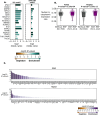Annotation of nuclear lncRNAs based on chromatin interactions
- PMID: 38709794
- PMCID: PMC11073715
- DOI: 10.1371/journal.pone.0295971
Annotation of nuclear lncRNAs based on chromatin interactions
Abstract
The human genome is pervasively transcribed and produces a wide variety of long non-coding RNAs (lncRNAs), constituting the majority of transcripts across human cell types. Some specific nuclear lncRNAs have been shown to be important regulatory components acting locally. As RNA-chromatin interaction and Hi-C chromatin conformation data showed that chromatin interactions of nuclear lncRNAs are determined by the local chromatin 3D conformation, we used Hi-C data to identify potential target genes of lncRNAs. RNA-protein interaction data suggested that nuclear lncRNAs act as scaffolds to recruit regulatory proteins to target promoters and enhancers. Nuclear lncRNAs may therefore play a role in directing regulatory factors to locations spatially close to the lncRNA gene. We provide the analysis results through an interactive visualization web portal at https://fantom.gsc.riken.jp/zenbu/reports/#F6_3D_lncRNA.
Copyright: © 2024 Agrawal et al. This is an open access article distributed under the terms of the Creative Commons Attribution License, which permits unrestricted use, distribution, and reproduction in any medium, provided the original author and source are credited.
Conflict of interest statement
The authors have declared that no competing interests exist.
Figures






References
Publication types
MeSH terms
Substances
LinkOut - more resources
Full Text Sources
Research Materials

